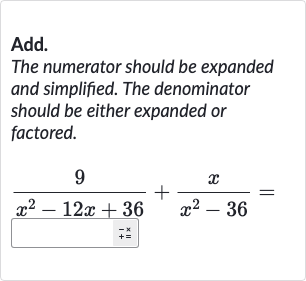Full solution
Q. Add.The numerator should be expanded and simplified. The denominator should be either expanded or factored.
- Factor denominators: First, we need to factor the denominators of both fractions to see if they can be simplified or if there is a common denominator.The first denominator is . This is a perfect square trinomial and can be factored as .The second denominator is . This is a difference of squares and can be factored as .
- Write fractions with factored denominators: Now that we have factored both denominators, we can write the fractions with their factored denominators: becomes becomes
- Find common denominator: To add these fractions, we need a common denominator. The least common denominator (LCD) is .We will rewrite each fraction with the LCD as the denominator.
- Rewrite fractions with common denominator: The first fraction already has in the denominator, so it does not change:The second fraction needs to be multiplied by to have the LCD as the denominator:
- Add fractions: Now we can add the two fractions with the common denominator: +
- Combine numerators: Combine the numerators over the common denominator:
- Expand and simplify numerator: Expand and simplify the numerator:
- Final simplified form: Now we have the simplified numerator over the common denominator:
- Final simplified form: Now we have the simplified numerator over the common denominator: We can check if the numerator can be factored further, but it is already a perfect square trinomial, so it cannot be factored further. The final simplified form of the sum is:
More problems from Factor sums and differences of cubes
QuestionGet tutor help
QuestionGet tutor help

